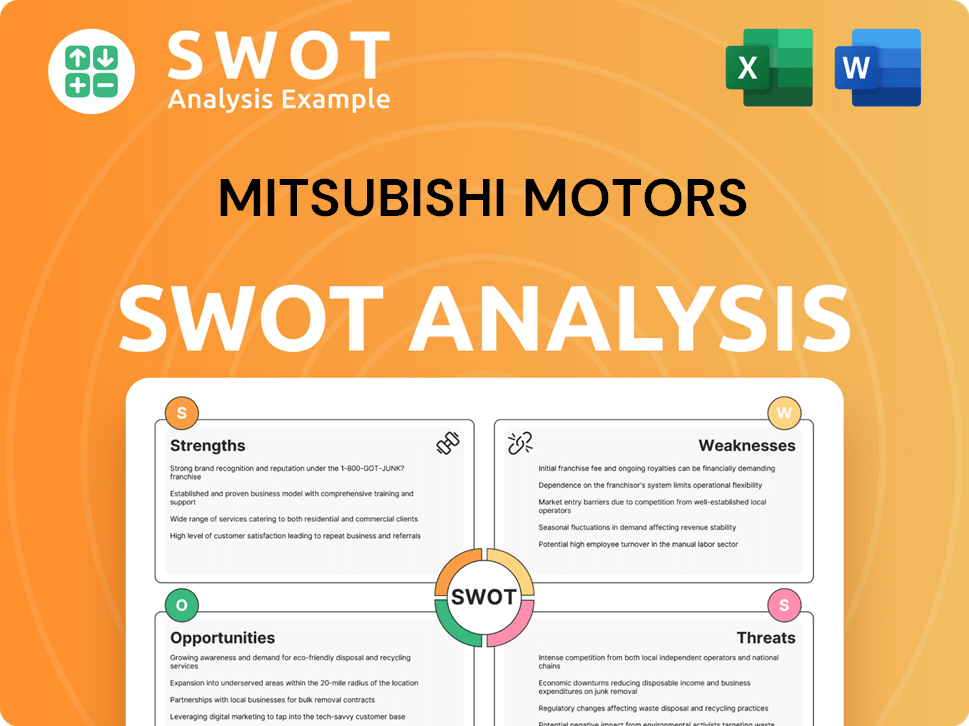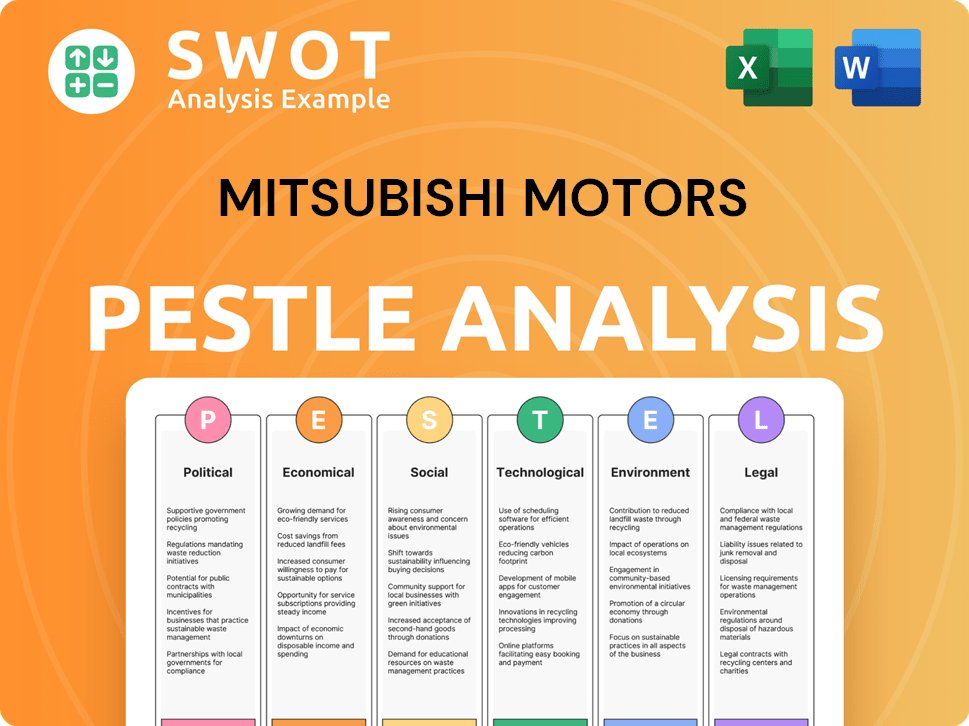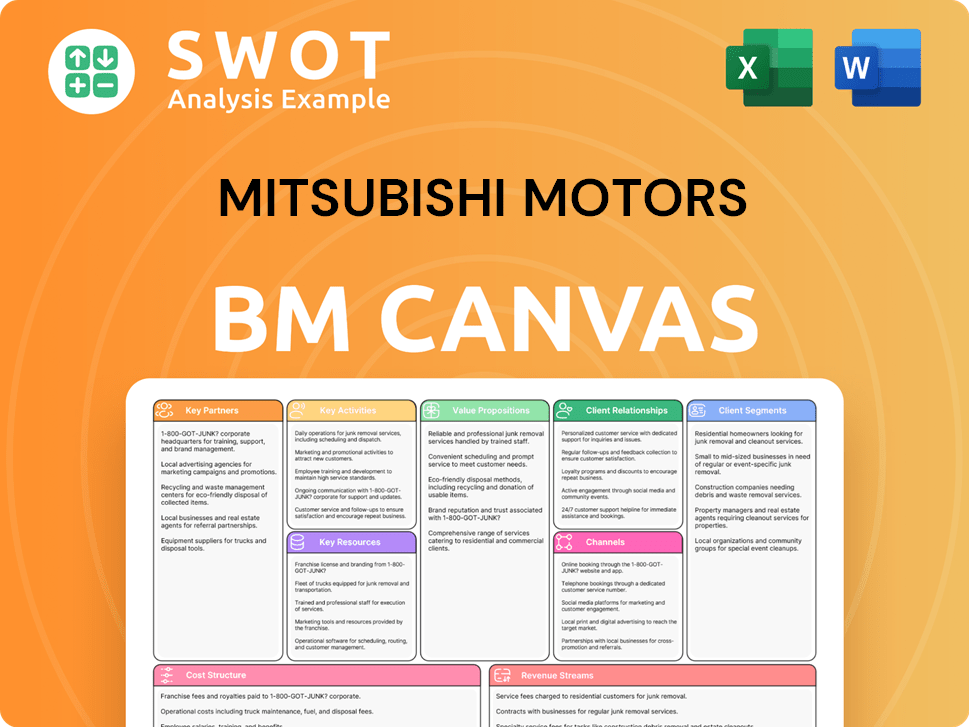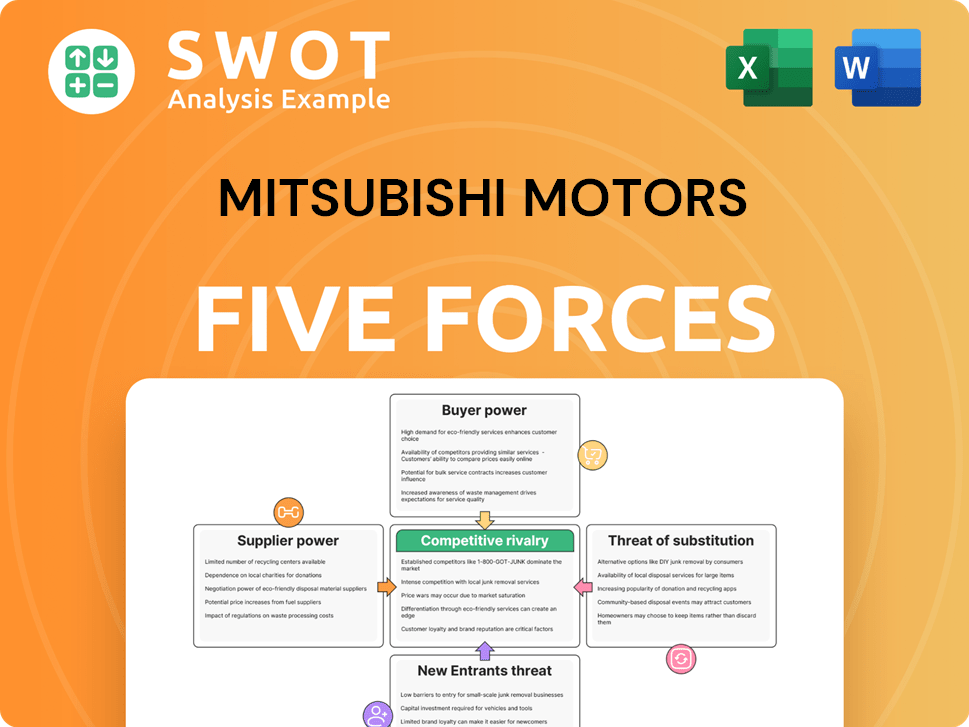Mitsubishi Motors Bundle
Can Mitsubishi Motors Drive its Future Success?
Mitsubishi Motors, a century-old automotive giant, is navigating a rapidly evolving industry. From its humble beginnings to a global presence, the company's commitment to manufacturing has been unwavering. Today, Mitsubishi Motors faces the challenge of adapting to the shift towards electrification and sustainable mobility.

This exploration delves into the Mitsubishi Motors SWOT Analysis, examining its growth strategy and future prospects within the dynamic automotive industry. We will analyze Mitsubishi Motors' strategic planning, market analysis, and expansion plans, including its focus on electric vehicles, to understand its potential for long-term success. The company's 'Challenge 2025' plan and sustainability initiatives will also be examined to provide a comprehensive view of its future trajectory.
How Is Mitsubishi Motors Expanding Its Reach?
Mitsubishi Motors is aggressively pursuing expansion, focusing on its 'Challenge 2025' mid-term business plan. This plan includes launching 16 new models within five years, with a strong emphasis on electric and hybrid vehicles (xEVs). The company aims to have 100% of its sales from electrified vehicles by 2035, supported by significant investments in battery procurement.
Geographically, Mitsubishi Motors is concentrating on the ASEAN and Oceania regions to boost sales, market share, and revenue. Product-wise, the company plans to introduce new models across various segments, including a three-row SUV and two fully electric options in 2025. This strategy is supported by strategic partnerships and investments to enhance its market presence and product offerings.
The company’s expansion strategy is multifaceted, involving both organic growth and strategic partnerships. This approach is designed to strengthen its position in key markets and adapt to the evolving demands of the automotive industry. A deeper look into the Marketing Strategy of Mitsubishi Motors reveals the company's comprehensive approach to growth.
Mitsubishi Motors is prioritizing the ASEAN and Oceania regions for growth. This focus aims to increase sales volume, market share, and overall revenue. The company is investing resources to strengthen its position in these key markets.
A major component of Mitsubishi Motors' strategy is the expansion of its electric and hybrid vehicle offerings. The goal is to increase the sales ratio of electrified vehicles to 100% by 2035. This strategy is supported by substantial investments in battery procurement.
Mitsubishi Motors plans to introduce new models across various segments to meet diverse customer demands. Upcoming launches include a three-row SUV, a smaller vehicle, and two fully electric options in 2025. These new models are expected to drive sales growth.
The company is leveraging partnerships to expand its business and market reach. These collaborations include establishing financing services and exploring opportunities to supply EV models in the Oceania region. These partnerships are vital for growth.
In the Philippines, Mitsubishi Motors achieved record retail sales of 91,639 vehicles in FY2024, marking a 12% increase and capturing a 19.5% market share. Vietnam saw a 44% rise in sales volume to 43,065 vehicles, with market share increasing to 13.3%. Indonesia secured an 8.2% market share in FY2024, aiming for 10% in FY2025. Mexico reported a 28.8% sales growth in 2024, selling 24,706 units.
- Focus on ASEAN and Oceania regions for sales growth.
- Target of 100% electrified vehicle sales by 2035.
- Introduction of new models, including EVs and SUVs, in 2025.
- Strategic partnerships to expand market reach and services.
Mitsubishi Motors SWOT Analysis
- Complete SWOT Breakdown
- Fully Customizable
- Editable in Excel & Word
- Professional Formatting
- Investor-Ready Format

How Does Mitsubishi Motors Invest in Innovation?
Mitsubishi Motors is heavily investing in innovation and technology as a core element of its growth strategy. This strategic focus aims to enhance its market position and secure its future prospects within the competitive automotive industry. The company's commitment to technological advancements is evident in its substantial financial allocations and strategic partnerships.
The company's investments are primarily directed towards electrification and advanced driving technologies. This proactive approach is designed to meet evolving customer needs and align with global trends towards sustainable and technologically advanced vehicles. These investments are crucial for the company's long-term strategic goals.
Mitsubishi Motors is working on several initiatives to stay competitive. The company is focusing on developing Battery Electric Vehicles (BEVs) and integrating advanced driver-assistance systems into its vehicles. These efforts reflect the company's commitment to innovation and its vision for the future of mobility.
Mitsubishi Motors has allocated approximately ¥500 billion (around $4.5 billion) through 2024 for research and development (R&D) in electrification and advanced driving technologies. Total R&D expenses for FY2024 were ¥126.7 billion, an 11% increase year-over-year.
The 'Challenge 2025' plan outlines a 30% increase in R&D expenses and CAPEX over the six years to 2028. Approximately 70% of this funding will be directed at the design and production of Battery Electric Vehicles (BEVs) starting in 2026.
Mitsubishi Motors aims to introduce several autonomous models by 2025. Their goal is to offer fully autonomous vehicles to the public by 2030 through partnerships with tech companies.
The company is integrating advanced connectivity and driver-assistance systems into its 2025 models. These include larger infotainment screens, wireless Apple CarPlay and Android Auto, sophisticated cruise control, and comprehensive camera systems.
Mitsubishi Motors launched the i-MiEV, the world's first mass-produced electric vehicle, in 2009, followed by the Outlander PHEV in 2013. This demonstrates their commitment to sustainability.
Collaborations with companies like Kaluza Japan for smart charging services and Yanekara for controllable EV recharging facilities show a commitment to new business models and monetizing connected EV technologies.
Mitsubishi Motors is focusing on integrating advanced technology in all aspects of vehicle development, including energy management and the reuse of used batteries. This comprehensive approach supports its long-term strategic goals and enhances its competitive position within the automotive industry.
- Electrification: Significant investment in Battery Electric Vehicles (BEVs) and Plug-in Hybrid Electric Vehicles (PHEVs).
- Autonomous Driving: Development of autonomous models with a target for fully autonomous vehicles by 2030.
- Connectivity: Integration of advanced connectivity features such as wireless Apple CarPlay and Android Auto.
- Driver-Assistance Systems: Implementation of sophisticated cruise control, camera systems, and Mi-Pilot Assist.
- Sustainability: Focus on EV technology, smart charging services, and battery reuse.
Mitsubishi Motors PESTLE Analysis
- Covers All 6 PESTLE Categories
- No Research Needed – Save Hours of Work
- Built by Experts, Trusted by Consultants
- Instant Download, Ready to Use
- 100% Editable, Fully Customizable

What Is Mitsubishi Motors’s Growth Forecast?
The financial outlook for Mitsubishi Motors reveals a mixed performance in FY2024. While net sales remained stable at ¥2,788.2 billion, the company experienced a decrease in operating and net income. Retail sales volume saw a year-over-year increase, indicating some growth in the market. The company is also increasing its dividend, which may be a positive signal to shareholders.
Looking ahead, Mitsubishi Motors anticipates growth in earnings and revenue. The company's mid-term business plan, 'Challenge 2025,' sets ambitious targets for sales volume and operating profit. Significant investments in research and development (R&D) and capital expenditure (CAPEX) are planned to support future growth and innovation, which is crucial in the competitive Owners & Shareholders of Mitsubishi Motors.
The company's strategic focus on increasing investment in R&D and CAPEX by approximately 30% over the next six years underscores its commitment to long-term growth. This investment strategy is essential for staying competitive in the automotive industry and achieving its future prospects.
In FY2024, net sales were stable at ¥2,788.2 billion. Operating profit reached ¥138.8 billion, with an operating margin of 5.0%. Net income was ¥41.0 billion, reflecting a decrease from the previous year. These figures provide a snapshot of the company's financial health and its ability to navigate market challenges.
Retail sales volume increased to 842,000 units. The annual dividend is set to increase by ¥5 to ¥15 per share. These metrics are important indicators of the company's market presence and its commitment to shareholder value.
The company anticipates earnings to grow by 26% and revenue by 0.5% per annum. EPS is expected to grow by 27.6% per annum, with a forecasted return on equity of 7.6% in three years. These forecasts suggest a positive outlook for Mitsubishi Motors' future prospects.
Capital expenditure for FY2024 was ¥100.6 billion, and R&D expenses were ¥126.7 billion. The 'Challenge 2025' plan aims for a sales volume of 1.1 million vehicles and an operating profit of ¥220 billion. These investments are crucial for the company's growth strategy.
The automotive industry is highly competitive. Mitsubishi Motors needs to stay ahead of the curve by investing in new technologies and expanding its market presence. Understanding market trends and consumer preferences is critical for success.
Strategic planning is essential for achieving long-term goals. Mitsubishi Motors' 'Challenge 2025' plan provides a roadmap for future growth. Regular reviews and adjustments to the strategy are necessary to adapt to changing market conditions.
The competitive landscape includes both established automakers and new entrants. Mitsubishi Motors must differentiate itself through innovation, quality, and customer service. Monitoring competitors' strategies is crucial for maintaining a competitive edge.
Analyzing financial performance provides insights into the company's health. Key metrics include revenue, profit margins, and return on equity. Regular financial analysis helps in making informed decisions and adjusting strategies as needed.
Investment in technology is vital for the automotive industry. Mitsubishi Motors is focusing on R&D to develop new models and improve existing ones. This includes electric vehicles and autonomous driving technologies.
Sustainability is becoming increasingly important. Mitsubishi Motors is likely to focus on eco-friendly practices and the development of electric vehicles. This will help the company meet environmental regulations and appeal to environmentally conscious consumers.
Mitsubishi Motors Business Model Canvas
- Complete 9-Block Business Model Canvas
- Effortlessly Communicate Your Business Strategy
- Investor-Ready BMC Format
- 100% Editable and Customizable
- Clear and Structured Layout

What Risks Could Slow Mitsubishi Motors’s Growth?
Examining the potential risks and obstacles is crucial for understanding the competitive landscape of Mitsubishi Motors and its future prospects. The automotive industry is highly competitive, and Mitsubishi Motors faces numerous challenges that could impact its growth strategy. These challenges range from market competition to technological disruptions and internal resource constraints.
The company's strategic planning must account for these factors to ensure sustainable growth. The ability to adapt to changing market dynamics, invest in new technologies, and efficiently manage resources will be critical to its success. Addressing these risks proactively will be essential for Mitsubishi Motors to achieve its long-term strategic goals.
Mitsubishi Motors faces significant risks that could impede its growth. Intense competition within the Automotive Industry, particularly from established players such as Toyota and Nissan, puts pressure on its market share. Regulatory changes, especially concerning environmental standards and the shift towards electric vehicles (EVs), present ongoing challenges.
The automotive market is highly competitive, with rivals such as Nissan, Hyundai, and Toyota. This competition, particularly in North America and Oceania, has led to increased incentives and a deterioration in sales expenses. In FY2024, this resulted in a ¥7.1 billion increase in sales expenses.
Regulatory changes, particularly those related to environmental standards and the electrification of vehicles, pose ongoing challenges. The need to comply with stricter emissions standards and invest in electric vehicle technology requires significant resources and strategic adjustments. This impacts the company's future of electric vehicles for Mitsubishi.
Supply chain vulnerabilities continue to be a concern. Production capabilities are subject to component shortages from suppliers or region-specific issues. While Mitsubishi Motors largely offset the impact of inflation and increased shipping costs, procurement and shipping costs still had a negative impact of ¥2.6 billion in FY2024.
The rapid evolution of autonomous driving and connected vehicle technologies requires significant R&D investment. A lower R&D investment compared to rivals could limit Mitsubishi Motors' innovation ability. This includes the future of autonomous driving.
Internal resource constraints, such as unsteady leadership and frequent top management changes, can cause a lack of direction and harm staff morale. These issues can hinder the effective implementation of the company's growth strategy.
The appreciation of the Thai Baht, a cost currency, had a negative impact on exchange rates in the second half of FY2024. This impacts Mitsubishi Motors' financial performance analysis.
To mitigate these risks, Mitsubishi Motors is focusing on diversification of its product portfolio. This includes a strong emphasis on sustainable mobility, such as hybrid and electric models. The 'Challenge 2025' plan focuses on establishing a stable revenue base through selection and concentration in regional strategies.
Mitsubishi Motors is expanding its market share in core markets by refreshing models, accelerating electrification, and strengthening its sales network. The company aims to build long-term relationships of trust with customers through its products and technology. This includes focus on Mitsubishi Motors expansion plans in Europe.
Mitsubishi Motors Porter's Five Forces Analysis
- Covers All 5 Competitive Forces in Detail
- Structured for Consultants, Students, and Founders
- 100% Editable in Microsoft Word & Excel
- Instant Digital Download – Use Immediately
- Compatible with Mac & PC – Fully Unlocked

Related Blogs
- What are Mission Vision & Core Values of Mitsubishi Motors Company?
- What is Competitive Landscape of Mitsubishi Motors Company?
- How Does Mitsubishi Motors Company Work?
- What is Sales and Marketing Strategy of Mitsubishi Motors Company?
- What is Brief History of Mitsubishi Motors Company?
- Who Owns Mitsubishi Motors Company?
- What is Customer Demographics and Target Market of Mitsubishi Motors Company?
Disclaimer
All information, articles, and product details provided on this website are for general informational and educational purposes only. We do not claim any ownership over, nor do we intend to infringe upon, any trademarks, copyrights, logos, brand names, or other intellectual property mentioned or depicted on this site. Such intellectual property remains the property of its respective owners, and any references here are made solely for identification or informational purposes, without implying any affiliation, endorsement, or partnership.
We make no representations or warranties, express or implied, regarding the accuracy, completeness, or suitability of any content or products presented. Nothing on this website should be construed as legal, tax, investment, financial, medical, or other professional advice. In addition, no part of this site—including articles or product references—constitutes a solicitation, recommendation, endorsement, advertisement, or offer to buy or sell any securities, franchises, or other financial instruments, particularly in jurisdictions where such activity would be unlawful.
All content is of a general nature and may not address the specific circumstances of any individual or entity. It is not a substitute for professional advice or services. Any actions you take based on the information provided here are strictly at your own risk. You accept full responsibility for any decisions or outcomes arising from your use of this website and agree to release us from any liability in connection with your use of, or reliance upon, the content or products found herein.